
14 minute read
Editorial
In the last issue of the Free State News, Vanessa invited the members to share their travel stories with the rest of us. In late May I qualified to be one of 6 paying guest crew members on the Pride of Baltimore. In June, July, August and September the Pride sailed up the Atlantic Ocean, into the St. Lawrence River to the Great Lakes to be part of the 2019 Great Lakes sail and race event. An event where a number of tall ships from around North America sail the great lakes to be part of festivals in US and Canadian cities on the lakes.
More details about the Pride later in this article. My two tours of duty with the Pride were for one week in June from Baltimore to Lunenburg, Nova Scotia and again for 11 days in July on Lake Erie, Lake Huron and Lake Michigan.
Advertisement
On Wednesday June 5 by 13.00 EDT I reported to the Pride’s winter berth, dockside on Clinton Street in Baltimore. The regular permanent crew of 12 was busy with all the last-minute activities and supplies to go on board. Right away all guest crew jumped in and helped and that is the way it was all during the trip.
Around 17.00 EDT we left for a short stay in the inner harbor for a farewell event on the pier next to the Constellation where some members of the Fort McHenry Fife and Drum corps welcomed us. The executive director of the Pride and his staff, introduced the crew to the politicians, partners and sponsors who all had kind words for the Pride to again be the ambassador for Baltimore and Maryland and promote all things good. Once we left the pier on the way out the Patapsco River, we gave a cannon salute. Many vessels escorted us out towards Fort McHenry. We had to go back to our Clinton Street berth till around midnight to wait for the proper tide and currents going up the Chesapeake Bay into the C&D canal and Delaware Bay. That night the guest crew members received from the 2nd mate, detailed orientation about the do’s and don’ts and safety procedures.
As soon as we left the dock the watches started. A watch (12 to 4), B watch (4 to 8) and C watch ( 8 to 12) every 12 hours. This trip I was on the B watch. At around daybreak I was on watch and enjoyed the first and one of the many sunrises this time in the upper Chesapeake Bay into the C & D canal. Once on the ocean we were able to set some sail, however on the way up the Atlantic coast we had to motor sail a lot, because the wind was on our nose and we had a schedule to follow.
What is there to do on a watch? Well, number one, a crew of 4 or 5 will have to keep the vessel on course and, yes indeed, with help of a permanent crew member, I was asked to take the helm on every watch for an hour and keep the Pride on course. Afterwards, back home again, knowing that I did sail a vessel with or without the almost 10.000 square feet of sail on the ocean, is one of the most exhilarating experiences I ever had.
How do you keep course without any land in site for 360 degrees? You make use of the clouds, stars and moon AND you need to get a feel for the vessel so that the bowsprit does not travel towards port or starboard on the horizon. Only keep an eye on the needle of the compass to confirm the heading ordered.
During a watch you are asked to do a boat check. Bilges in every compartment need to be checked for water. Check the air in the lifeboat called the Chasseur. Check oil pressure, water level, amps and voltage on both engines. Check generator and water maker. Check all the halyards to be free and on the right pins on the pin rails. All details to be recorded in a log. Thursday June 6 at 1100 EDT we were on the Delaware Bay motoring through smooth water and no wind. While in the Delaware Bay the captain mustered us and informed us about the course to be taken on the ocean and what each one of us including crew and guest will need to do in case of fire and man overboard.
Friday June 7 0800 EDT 30 nautical miles east of Manasquan inlet, NJ and 30 nautical miles south of Jones Beach, Long Island. Doing 6+ knots and rolling with 4 to 5-foot swells (and loving it). Saturday June 8 0600 EDT We did not stay close to Long Island, but the captain made the choice for the Cape Cod Canal to Heget further north before heading east across the Gulf of
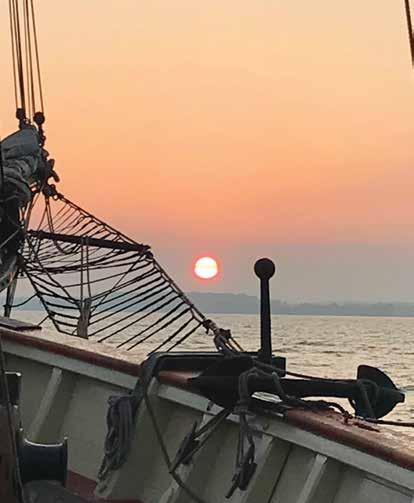
Maine towards Nova Scotia. The forecast did indicate better winds to raise the sails next week.
We were anchored Saturday afternoon and evening at Provincetown, Mass. Some of us wanted to cool off and went swimming in Cape Cod Bay. Sunday June 9 2019 0800 EDT After a good night sleep for all of the crew, we were mustered and the captain explained to us what we had done, why we were anchored etc. etc and what the plan is for the next few days. Before we weighed anchor (all by hand amazing to see) the first mate ordered all of us to swab, clean and wipe the teak and varnished areas on the deck in detail.
We had favorable southwesterly winds between 10 and 15 knots. All sails were set. That is what sailing on the Pride is all about. Sails include mainsail, foresail, forestaysail, jib, jib-topsail, main-gaff-topsail, squarefore-topsail, square top gallant and studding-sail. Around 15 knots of wind we were doing 8+ knots of speed heeling around 5 degrees. Around 15 knots of wind we were doing 8+ knots of speed heeling around 5 degrees. Far into the ocean no land in site, around 17.00 hour we had some visitors around the Pride. Whales and dolphins/porpoises gave us a nice show. Monday June 10 0600 EDT Sailing just the way we like it at a speed of 6-8 knots. Location is 80 miles WSW of Cape Sable Nova Scotia, Canada. Tuesday June 11 16.00 ADT Arrived in Lunenburg. One day earlier than scheduled. We had sailed with all sails up from Sunday noon till Monday noon about 170 nautical miles calm seas and speed from 6 to 8 knots to almost 9 knots south easterly winds 10 to 15 knots. The welcome in Lunenburg, with a couple of cannon salutes by the Pride, was very friendly by the locals and our friends on the sailing vessels Picton Castle and Bluenose II. ALL sails had to be packed correctly. This is when the guest crew was invited to climb up the rigging and help pack the sail on the top yard (cross bar). Yes, of course I did and had the time of my life, clipped in, enjoying the view while helping pack the sail. Lunenburg, Nova Scotia is a lovely town, like Annapolis and Chestertown but on steroids. The town was settled around 1750 by the Swiss, Germans, and French.
Being carpenters and masons, these settlers became shipwrights to build many a fishing boat. It is one of the UNESCO world heritage sites. That means, just like Brugge in Belgium and part of Amsterdam in the Netherlands and more places around the globe, the local, state and federal governments, partnering with UNESCO (a United Nation agency) will preserve and legally protect and restore it, if needed, the way it was built many years ago.
After a few more days in Lunenburg I flew back to Baltimore with memories of a lifetime.
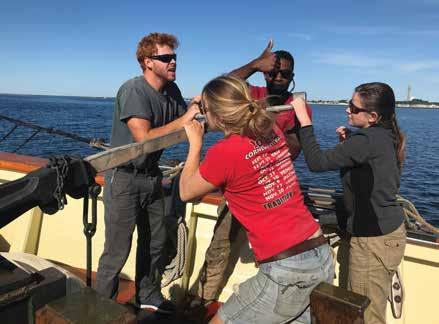
P.S. Out the 3 races on the Lakes, Pride won 2, and came in second once.
More about the Pride: Did I forget to tell you that Phil (in his early sixties?) the cook on board provided us with 3 meals a day. From bacon, sausage, eggs, grits, pancakes etc. etc in the morning, to wraps, grilled cheese, tacos, etc. for lunch and pork chops, baked beans, rice, salad, and chicken dishes for dinner, with plenty of fruit and vegetables. What an amazing job he does, providing nutrition for 18 crew members 3 times a day. About the crew: Captain Jan Miles (in his late sixties?) has been captain and or associated with the Pride since before it was built on the banks of the Inner Harbor between the Science and Visitors’ Center in late summer of 1986. Never met a more capable and knowledgeable sailor like him before. His concern first and always is the safety of crew and vessel. He knows every square inch of the Pride and every square inch of its sails.
The remainder of the crew is either half my age or a third my age. But WOW, when given a command or order to raise or douse a sail or sails, they all can do this as a team almost blind folded, day and night. The guest crew is expected to assist including sweating the lines, meaning 4 or 5 crewmembers, not only with your arms but with all of your body, pulling and driving the halyards to the pins while someone is tailing the line. “
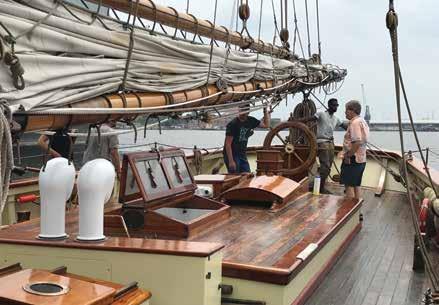
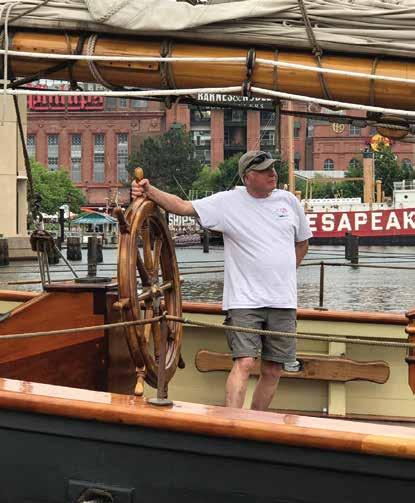
More details of the Pride of Baltimore II: It took almost 2 years to build the Pride and in April of 1988 was lifted into Baltimore harbor. In October of 1988 she was commissioned in Fells Point. It is a topsail schooner. She is about 157’ long from bowsprit to stern the rigging height is 107’, with a beam of 26’4”. The draft is 12’6”, wooden hull and 2- 165 HP Caterpillar diesel engines.
For the guest crew the Pride has 3 bunks (2 people per bunk, male or female) with a top and bottom bunk. I was happy to get a bottom bunk. These bunks are located mid ship next to the salon eating area and galley. These bunks have solid doors for privacy. Captain, first and second mate have bunks aft. The rest of the crews bunks forward.
Just like the Pride of Baltimore I (lost at sea in 1986 after 9 years) the Pride II is a replica of iconic vessels, built in Baltimore in the late 1700’s in the Fells Point area, called the Baltimore Clippers. They were used not only for commerce (including rum running), sailing up and down the Atlantic into the West Indies, but were of significance during the war of 1812, and afterwards. Such a ship was called a privateer. A privately-owned armed ship permitted by its
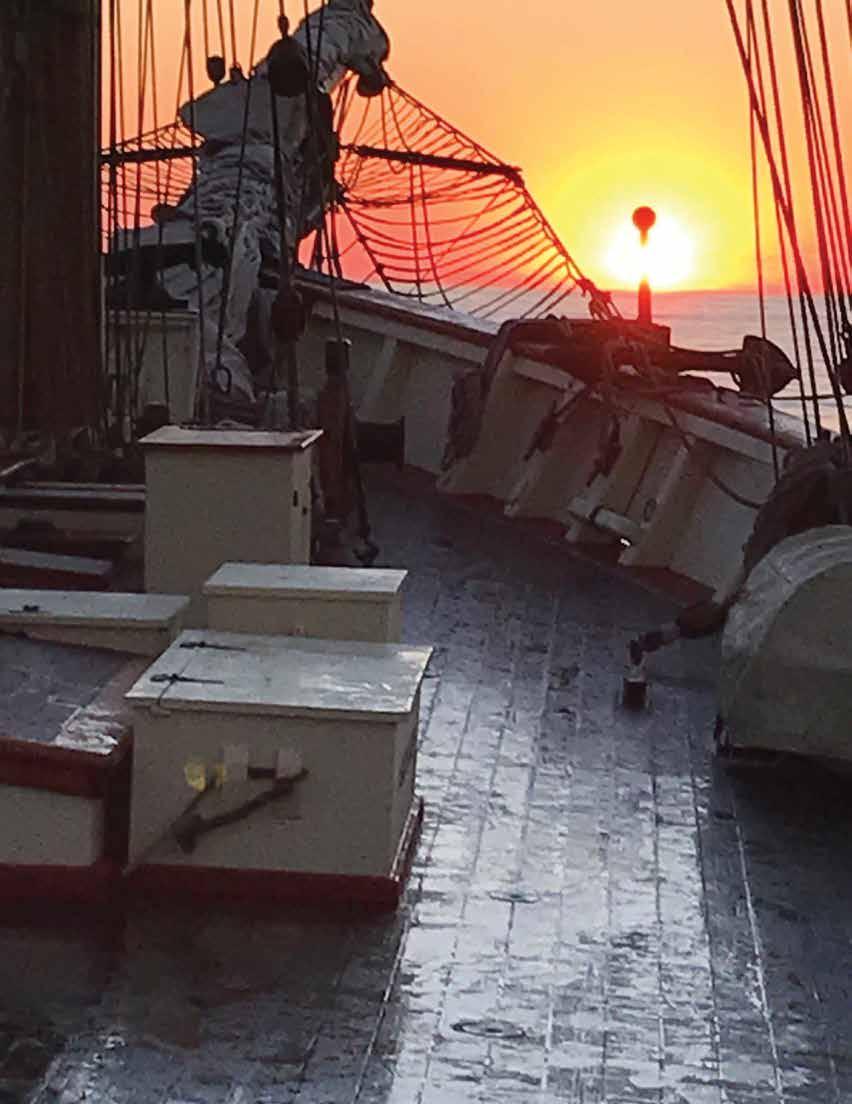
“
government (it was drafted like that in our constitution) to make war on ships of an enemy country. During those days America did not really have a navy strong enough to fight the mighty British Royal Navy. So, privateers were called in and during the end of that war they helped to deliver the decisive victory for the United States.
One such ship owned by William Hollins and Thomas Kemp the builder, named the Chasseur commanded by Captain Thomas Boyle and manned with American privateers during the war of 1812, captured close to 2 dozen commercial British ships. They sold the goods and the ship divided the proceeds between crew, sponsors, owners and government and released the crew to go onto the next hunt.
On her return to Baltimore on April 15, 1815, the Baltimoreans were so proud that they renamed the shipped The Pride of Baltimore.
Just a little about the Pride’s history. ❦
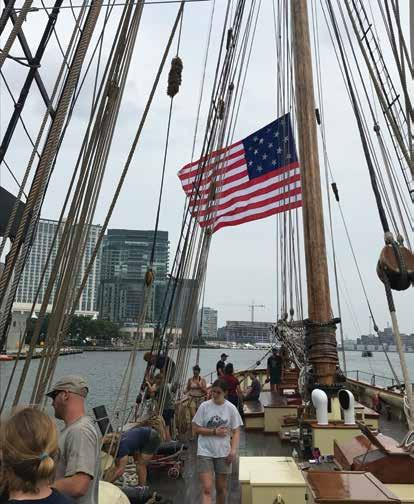
William Verbrugge Nursery Sales Associate wverbrugge@yahoo.com


Contact information on the Pride of Baltimore II
Pride of Baltimore, Inc. 1240 Key Highway, Baltimore, Maryland 21230 Phone: 410.539.1151 Email: pride2@pride2.org
Education Ronda Roemmelt – Chair Angela Burke Dave Clement Hank Doong Stanton Gill Brett Karp Mary Kay Malinoski Brian Mitchell John Murphy Karen Rane Andrew Ristvey Ginny Rosenkranz Chuck Schuster Heather Zindash
Nominating Mark Dougherty – Chair Richard J. Watson
Finance and Planning Carrie Engel – Chair Jessica Todd Larry Hemming John Murphy
Link/Shanks Scholarship Mark Dougherty – Chair MANTS Jan S. Carter Bernard E Kohl, Jr. William A. M. Verbrugge
Membership Committee Rich Poulin Greg Stacho
Awards - Professional Achievement, Carville M. Akehurst Michael Marshall– Co-Chair Kevin Clark - Co-Chair Legislative/MaGIC James R. McWilliams– Chair Mark Schlossberg All Officers and Directors Alan Jones Bernie Kohl
CPH George Mayo - Chair Steve Black Cindy King Andrew Ristvey Martha Simon-Pindale Bob Trumbule Jamie Tsambikos Gaye Williams Jon Vander Vliet
Scholarship Bernie Kohl, Jr. – Chair Hank Doong Leslie Hunter-Cario Jessica Todd George Mayo Mary Claire Walker
Economic Survey Steve Black Larry Hemming Bernie Kohl George Mayo John Murphy Jessica Todd Dr. John Lea-Cox Kimberly Rice Dr. Andrew Ristvey
Historian George Mayo – Chair ADVISORS TO THE BOARD University of Maryland Dr. John Lea-Cox
MD Department of Agriculture Kimberly Rice
ADVISORS TO OTHERS CCLC – Ches. Bay Professional Landscape Certification (CBPL) Kody Cario
Invasive Plant Advisory Committee Brent Cassell Leslie Hunter Cario Kelli McGaw
LEAD Maryland Vanessa Finney
Maryland Agriculture Commission Ray Greenstreet
Maryland Farm Bureau Larry Hemming
MAEF George Mayo
Maryland Invasive Species Council (MISC) Brian Mitchell Alex Betz
University of Maryland – Dean’s Global Leadership Council Vanessa Finney
Young Farmers Advisory Council Jessica Todd
Every member of every committee listed above is an individual who volunteers their time in support for the MNLGA and it is with the utmost gratitude and appreciation that we thank you for your selfless endeavors. If your name is not listed above, please consider following the example of those who are. Contact Vanessa at 410-823-8684 with your interest.
MARYLAND NURSERY, LANDSCAPE AND G REENHOUSE ASSOCIATION, I N C .
Mission Statement
The purpose of the Maryland Nursery, Landscape and Greenhouse Association is to promote the use of ornamental plants, products, and services. The association supports all constituent groups of the horticulture industry including landscape, garden centers, interiorscape, grounds maintenance, nursery, greenhouse, and arboriculture. The association communicates the role of the horticulture industry in improving people’s quality of life.
Specific Goals
Promote professionalism through education programs for members and the public and by encouraging enrollment in educational institutions.
Monitor state and local laws relating to horticulture industry.
Participate actively in legislative and regulatory processes.
Promote the use of environmentally sound practices in the horticulture industry.
Monitor and communicate to members developments in allied industries including agritechnology.
Support donations of plant products and services to state and community programs.
Support research relevant to the horticulture industry.
Participate in Maryland agricultural organizations.
6good reasons your company should advertise in the MNLGA’s Free State Nursery, Landscape and Greenhouse News 1 2 3 4 5 6 Free State News is seen by members of Maryland’s Nursery, Landscaping, Greenhouse, Garden Center and Allied Industries and is the leading publication for members of the MNLGA Free State News helps support the association in its endeavors on behalf of the green industry in the state of Maryland Free State News enhances your ad with important industry specific content that is educational and informative. And, the digital version gives readers direct access to your website Free State News helps promote your company and product while providing direct access to readers in Maryland’s Green Industries Articles are contributed by highly regarded members of the industry, many of whom have a lifetime of knowledge and are frequently published Free State News is a cost-effective way to help keep your name out in front of the membership and your potential customers
For more information on advertising in the Free State Nursery, Landscape and Greenhouse News contact Kelly Finney at MNLGA at 410-823-8684 or e-mail office@mnlga.org
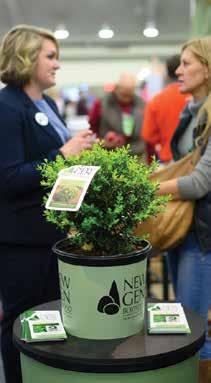
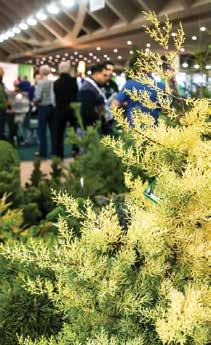
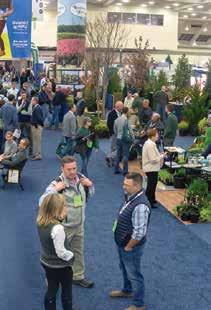
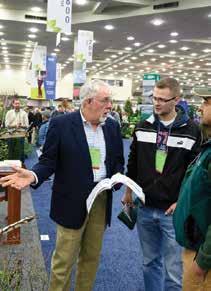
MANTS 2021 JANUARY 6-8 BALTIMORE CONVENTION CENTER
Be sure to mark your calendar and join us again next January! REMEMBER, MANTS MEANS BUSINESS


WE’RE GROWING FOR YOU


Foxborough Nursery, Inc.
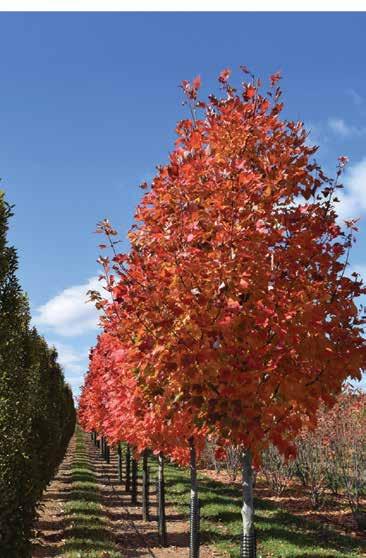

3611 Miller Rd. / Street, MD 21154 phone 410.836.7023 / fax 410.452.5131







